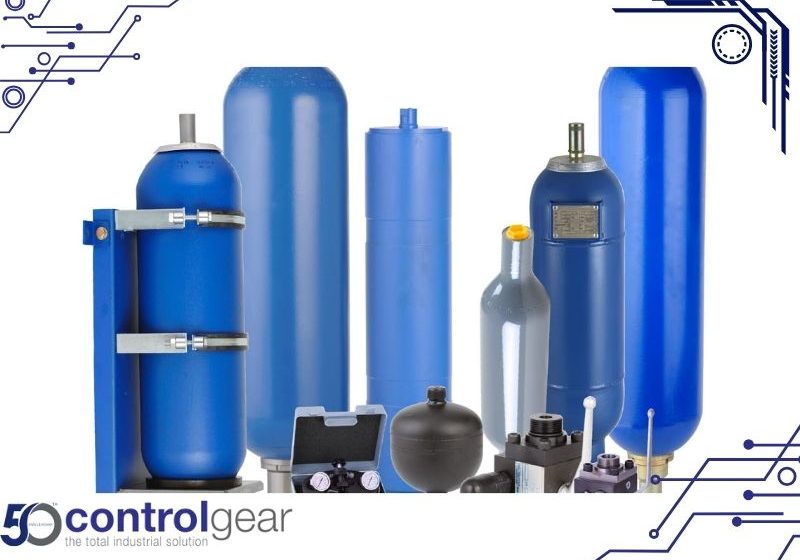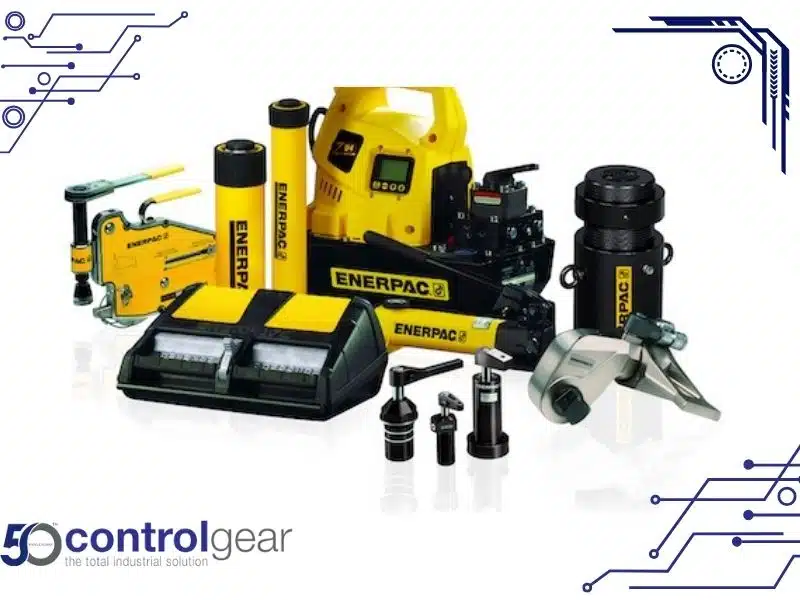
What are Hydraulic Accumulators?
In industrial hydraulics, the hydraulic accumulator is a key component that significantly boosts the efficiency and reliability of hydraulic systems: essentially, a hydraulic accumulator is a pressure vessel. It stores and disburses energy in the form of pressurised fluid. Acting like a battery within a hydraulic system, it helps maintain steady pressure levels, absorbs shocks, and compensates for fluid leakage.
The Functions of an Accumulator in a Hydraulic System
- Enhancing the performance of the hydraulic pump.
- Reducing the overall energy consumption.
- Providing an auxiliary power source during emergencies.
How Does a Hydraulic Accumulator Work?
A hydraulic accumulator is a gas-charged pressure vessel that stores hydraulic energy and releases it when needed. It works by separating pre-charged nitrogen gas from hydraulic fluid using a bladder, diaphragm or piston, depending on the accumulator type.
When system pressure rises, hydraulic fluid enters the accumulator, compressing the gas volume and storing energy. When system pressure falls, the compressed gas expands, forcing fluid back into the system. This helps maintain consistent pressure and flow.
The accumulator serves several key functions in a hydraulic system. It compensates for pressure fluctuations, supplements pump flow and protects components from shock and vibration. Many hydraulic systems use bladder-type accumulators for their rapid response and shock absorption properties.
Accumulators can also power actuators during shutdowns, support flow during peak demand, and maintain system pressure when minor leaks or thermal expansion occur. Systems without accumulators are less responsive and experience more wear and tear.
Selecting the appropriate accumulator volume and type ensures the system operates reliably under varying conditions.
Understanding Hydraulic Accumulators
A hydraulic accumulator is a type of energy storage device used in fluid power systems. It stores hydraulic fluid under pressure by compressing an inert gas, most often nitrogen. This stored energy is then available to support the system when extra pressure or flow is needed.
The hydraulic fluid is held within the accumulator and separated from the gas by a bladder, diaphragm, or, in some cases, a piston. As system pressure increases, hydraulic fluid enters the accumulator and compresses the gas. When system pressure is low, the gas expands and forces the fluid back into the system. This rapid exchange helps maintain consistent performance across the system and the accumulator.
Hydraulic systems use bladder accumulators when quick response and shock absorption are needed. Piston-type accumulators are preferred for larger volumes or higher pressures. The accumulator provides key benefits, including smoother operation, reduced wear on components, and improved energy efficiency. Without an accumulator, pressure fluctuations can cause instability and reduce the lifespan of system components.
Accumulators store energy that can also be used to power actuators during brief outages or as backup support. Accumulator size and gas pressure must be carefully matched to the system requirements. Understanding how different types of accumulators function is essential for selecting the right solution.
Accumulators are used in a wide range of industries, and choosing the correct type of accumulator ensures reliable and safe operation under varying pressure conditions.

Functions of Hydraulic Accumulators
Energy Storage and Release
The accumulator (hydraulic cylinder) stores energy in the form of compressed gas when the hydraulic circuit is at high pressure. It then releases the stored energy when the system pressure drops, boosting power.
Supplementing Pump Flow
During peak demand, an accumulator in a hydraulic system is used to supplement pump flow to the hydraulic components. This clever function allows the use of a smaller, less expensive pump without sacrificing performance.
Emergency Power Supply
In the unfortunate event of a power failure, accumulators can maintain system pressure temporarily. This ensures a safe shutdown of machinery preserving integrity and minimising risk.
Shock Absorption
Hydraulic systems need protection against unforeseen shocks and pulsations that might lead to costly damage. The buffering action of accumulators achieves this.
Maintaining System Pressure
Leakages and thermal fluctuations are inevitable in any hydraulic system, but accumulators compensate for this by maintaining the desired working pressure.
Three Main Types of Hydraulic Accumulators
Bladder Accumulators
Choose a bladder accumulator if you need the system to absorb shocks while maintaining pressure. A rubber bladder separates the gas from the fluid effectively. This separation ensures that the compressed gas expands and compresses without directly interacting with the fluid preventing contamination and ensuring a consistent pressure output. Bladder accumulators come in a variety of sizes and configurations making them adaptable to a wide range of system demands and capable of achieving higher compression ratios when the pressure exceeds the pre-charge pressure. Bladder accumulators discharge rapidly so they are ideal for hydraulic circuits that need quick responses.
Diaphragm Accumulators
Choose a diaphragm accumulator for your hydraulic system when system demands call for efficient, space-saving solutions in low-volume applications. The main advantage of using a diaphragm as the separator medium lies in its ability to maintain pressure and enable fluid to flow smoothly, ensuring operational efficiency. Diaphragm accumulators are available in various sizes and are suitable for applications where space is at a premium. They do not compromise performance. Their design allows for rapid response to pressure changes making them ideal for systems requiring precise pressure control and shock absorption.
Piston Accumulators
Choose a piston accumulator for high-pressure situations because it can handle substantial fluid volumes. The robust piston seal ensures a reliable separation between the gas and fluid segments. This is vital for maintaining system efficiency and preventing leakage. Piston accumulators come in various capacities and offer versatility when handling larger volumes and pressures. The piston accumulator is, therefore, an ideal choice for applications demanding precise hydraulic control and durability.
Benefits of Using Hydraulic Accumulators
System Efficiency
An immediately available energy reserve means quicker response times and an overall uptick in the operational efficiency of hydraulic systems.
Reduced Wear and Tear
Accumulators act as shock absorbers by extending the lifespan of components within the hydraulic system translating to fewer replacements and repairs.
Hydraulic Energy Savings
A hydraulic accumulator works to ease off the demands made on pumps during peak periods. This equals tangible energy reductions and cost savings.
Environmental Benefits
Less energy usage is good news for our planet – preventing unnecessary power use aligns with sustainable practices.
Safety and Reliability
Hydraulic accumulators are also critical because they have a failsafe role when power supplies falter.
Maintenance and Safety Considerations
Regular maintenance and inspections are imperative for trouble-free accumulator operation. Handling these high-pressure vessels requires caution, the right know-how, and safety measures. For example, knowing how to use nitrogen gas safely to pre-charge and pressurise accumulators is essential.
Choosing the Correct Accumulator
Opt for a new accumulator that suits your system’s pressure range and volume of fluid needed. Tailoring your choice to a specific hydraulic power application ensures performance and avoids over- or undersizing. Consult Control Gear and our hydraulic specialists can guide you toward the ideal selection.
Understanding the technical parameters:
- Evaluate system parameters such as maximum operating pressure, temperature range, and fluid compatibility.
- Assess the intended application to determine the appropriate size and type of accumulator.
- Consider the pre-charged pressure – critical for the correct functioning of the accumulator.
- Review the construction materials, especially the seals and diaphragm or bladder inside the accumulator, to ensure compatibility with the hydraulic fluid.
- Understand the certification and compliance standards that accumulators must adhere to, such as Pressure Systems Safety Regulations 2000 (PSSR) (S.I. 2000 No. 128), which cover most gas-loaded accumulators.
It is always best to incorporate these technical considerations before adding an accumulator into your system for optimal results.
Control Gear’s Hydraulic Accumulator Services
We are proud to be among the top UK suppliers and service providers for hydraulic accumulators. Our services include:
- Supply of new bladder and piston accumulators.
- Accredited workshop facilities.
- Repair and recertification services (PSSR S.I. 2000 No. 128).
- Same-day removal, recertification, and refit.
- Certified engineers.
- System design and build services.
For more information or case studies on our hydraulic accumulator expertise, contact us or visit our service page for insights.
Key Takeaways
The bottom line is that hydraulic accumulators are vital in modern hydraulic systems. Their abilities to boost efficiency, enact safety measures, and contribute to system reliability are just a few reasons why a quality accumulator, and its upkeep, should be viewed as vital investments in your business.
Are you looking to leverage the full potential of hydraulic accumulators for your operations? Contact Control Gear today, and our team of specialists will help you with accumulator selection and
system design, and answer any questions you may have.
FAQ
What types of hydraulic accumulators are available?
There are three types of hydraulic accumulators commonly used in industry. These include bladder-type, piston-type, and diaphragm accumulators. Each type functions slightly differently depending on how the hydraulic fluid is held and how the gas pressure is managed. Selecting the correct type of accumulator depends on system design, response time, and required accumulator size.
How does an accumulator support pressure in a hydraulic system?
Accumulators store hydraulic fluid under gas pressure and release it when the system pressure is low. This helps stabilise pressure in a system, especially during peak demand or rapid valve movements. The accumulator provides a consistent flow and can be connected to the hydraulic circuit near critical components to reduce shocks and maintain smooth operation.
Can accumulators be used to power systems during a shutdown?
Yes, accumulators may also be used to power essential movements during temporary power loss. By storing hydraulic energy in advance, the gas-charged accumulator forces the fluid back into the circuit when needed. This function is handy for ensuring a safe shutdown or emergency operation when pump power is unavailable.
